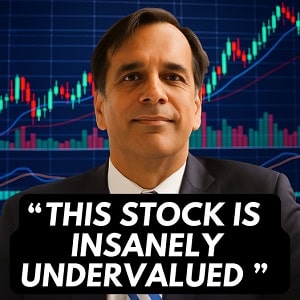As 2025 draws to a close, the stock market remains a tale of two worlds. On one side, artificial intelligence giants continue to ride the wave of the ongoing AI gold rush. NVIDIA’s blowout earnings and the launch of Google’s Gemini 3 last week sent a fresh jolt through the Nasdaq, calming nerves after a choppy autumn. On the other, broad market indices are posting massive daily ranges, a classic sign of indecision rather than conviction.
Even inside the once-invincible Magnificent 7, cracks are showing. Amazon (AMZN) and Meta Platforms (META) have lagged the performance of pure AI plays such as NVIDIA and Microsoft, highlighting extreme concentration risk at the very top of the market.
Within the financial sector, a similar bifurcation is playing out. Traditional mega-banks – JPMorgan Chase (JPM), Goldman Sachs (GS), and Bank of America (BAC) – have been among the steadiest performers of 2025, buoyed by resilient net interest margins and a “higher-for-longer” interest rate environment that never fully materialised but still delivered solid profitability.
Fintech, however, has been the polar opposite.
After enjoying explosive growth from 2020–2022, many high-profile fintech names spent 2023 and most of 2024 in the penalty box. A brief rotation back into “growth-at-any-price” stocks in late 2024 and early 2025 gave the sector a second wind, pushing valuations once again into nosebleed territory. That rotation has now decisively reversed.
Below is an in-depth, SEO-optimized analysis of why the fintech party may be ending – again – and why five of the most widely followed names look dangerously overvalued heading into 2026.
Why Fintech Stocks Are Suddenly Under Pressure Again
Macro Headwinds That Never Really Went Away
- Persistent inflation above the Fed’s 2% target has delayed meaningful rate cuts
- Consumer balance sheets are finally showing signs of fatigue after three years of excess savings depletion
- Rising credit-card and auto-loan delinquencies are flashing yellow (and sometimes red) across the economy
- Regulatory scrutiny on “Buy Now, Pay Later” and crypto exchanges has intensified
Sector-Specific Issues
- Competition in digital payments has exploded (Apple Pay, Cash App, Stripe, Adyen, local super-apps)
- Restaurants – a key vertical for several fintechs – are facing margin compression and lower traffic
- The crypto trade is once again correlated almost 1:1 with speculative sentiment rather than fundamentals
- AI-lending models are being stress-tested in real time as unemployment ticks higher
All of these forces have converged to create the perfect storm for many fintech valuations that still carry 2021-style multiples despite fundamentally slower growth.
The 5 Fintech Stocks That Look Most Vulnerable Right Now
PayPal Holdings Inc. (NASDAQ: PYPL) – The Fallen King of Digital Payments
From $308 to Sub-$62: Anatomy of a Lost Decade
PayPal’s rise and fall is one of the most dramatic stories of the post-COVID era. In just 16 months between March 2020 and July 2021, PYPL shares exploded from $85 to an all-time high of $308. By November 2025, the stock is trading around $61–$62, meaning an investor who bought at the peak has lost approximately 80% over four and a half years.
Even more telling: the stock is now below where it traded during the March 2020 pandemic low.
Valuation: Cheap on Paper, Expensive in Reality
At first glance, PayPal looks statistically cheap:
- Forward P/E ≈ 10.9x
- Price-to-sales ≈ 1.8x
- Enterprise value to free cash flow ≈ 11x
These are depression-era multiples for a company still generating more than $32 billion in annual revenue and $5–6 billion in free cash flow. So why isn’t the market rewarding it?
Because the market is no longer pricing PayPal as a mature cash cow – it is pricing it as a growth stock in secular decline.
Growth Is Decelerating Fast
Total payment volume (TPV) growth has slowed from 30–40% during the pandemic to low-teens in 2025. Venmo monetisation efforts have repeatedly disappointed. Braintree, once seen as the growth engine, is facing fierce competition from Stripe and Adyen.
Management’s Q4 2025 guidance (delivered in late October) explicitly warned of earnings deceleration as the company ramps up investment spending. Translation: margins will be sacrificed for the next several quarters with no guarantee of re-acceleration.
Technical Damage Is Severe
- Price well below both 50-day and 200-day moving averages
- Bearish MACD crossover confirmed in September 2025 and still widening
- RSI consistently below 50 since July, signalling persistent selling pressure
- Volume spikes on down days, light volume on any bounce attempts
Bottom line: PayPal may eventually stabilise as a boring, high-quality cash generator, but near-term there is little evidence the selling is exhausted. Investors still holding large positions from 2021–2023 may want to use any year-end strength to exit or drastically reduce exposure.
Toast Inc. (NYSE: TOST) – When 85x Forward Earnings Meets a Slowing Restaurant Industry
The Post-IPO Hangover That Refuses to End
Toast went public in September 2021 at roughly $40 and promptly ran to $69 within weeks. By June 2022 it had collapsed below $15. A powerful bear-market rally took it above $45 again in August 2025, but that proved to be the final exhaustion move. As of late November 2025, TOST trades in the low $30s.
Valuation Metrics That Make Value Investors Cry
- Forward P/E ≈ 85x (some analysts still have it north of 100x)
- Price-to-sales ≈ 3.5x on $4.7 billion run-rate revenue
- Net profit margin only 4.7% despite years of “scale advantages”
For context, Shopify – a far more diversified and profitable company – trades at roughly 11x sales and 100x forward earnings. Toast is asking investors to pay SaaS-like multiples for what is essentially a hardware-enabled payments business in a cyclical vertical.
Restaurants Are Hurting
U.S. same-store sales for limited-service restaurants have gone negative in three of the last five months (OpenTable and Black Box Intelligence data, November 2025). Higher menu prices are no longer translating into higher traffic – consumers are simply eating out less.
Toast’s core value proposition (higher attach rates for payments, payroll, loyalty, online ordering) works wonderfully in a booming environment. In a stagnant or contracting one, restaurant owners revert to cost-cutting mode and delay new software rollouts.
Technical Confirmation of the Reversal
After spending most of 2025 above its 200-day moving average, Toast broke down decisively in October. The 50-day moving average has now crossed below the 200-day – the classic “death cross.” MACD is deeply negative and RSI has not reached oversold territory (30) since the summer, meaning more downside is statistically likely before capitulation.
Coinbase Global Inc. (NASDAQ: COIN) – Still a Leveraged Bitcoin Proxy in Disguise
2025 Performance: A Giant Round Trip
Coinbase started 2025 around $175, surged above $370 in March when Bitcoin hit all-time highs, and now sits near $260–$270 after the latest crypto pullback. Net result for the year: barely positive, despite one of the most favourable regulatory backdrops in crypto history.
The Expense Problem No One Wants to Talk About
Q3 2025 earnings revealed a sharp rise in planned operating expenses for 2026 as Coinbase invests in custody, staking infrastructure, and international expansion. While long-term logical, the market hates seeing opex leverage in a cyclical business.
Valuation Is Still Lofty for a Trading Platform
- Forward P/E ≈ 41–45x
- EV/EBITDA ≈ 28x
- Trades at 12–15x consensus 2026 revenue
These multiples assume crypto trading volumes remain near peak levels forever. History suggests otherwise.
Technical Breakdown Is Clear
Coinbase spent almost the entire year respecting its 200-day moving average as support. That level failed spectacularly in early November 2025. The breakdown was accompanied by a massive volume spike and a bearish MACD crossover that continues to widen.
Unless Bitcoin stages an immediate and violent reversal above $110,000, Coinbase shares are likely to retest the $200–$220 zone seen in the summer.
Upstart Holdings Inc. (NASDAQ: UPST) – AI Lending Meets the Real World
The Meme Stock That Refused to Die (Until It Did)
Upstart was the poster child for 2021’s “AI will disrupt everything” mania. From $45 in late 2020, it rocketed to $401 in October 2021. The subsequent 95% crash brought it below $15 in 2022. A combination of approaching profitability and rate-cut hopes pushed it back above $100 briefly in early 2025. Reality has since set in again.
Valuation Remains Absurd
- Trailing P/E > 160x
- Forward P/E ≈ 18–20x (still requires 100%+ earnings growth in 2026)
- Price-to-sales ≈ 8x on a business that is barely profitable
November 4 Guidance Miss Broke the Spell
Despite reporting 71% revenue growth and positive EPS for the fourth straight quarter, management’s full-year outlook fell short of the most bullish sell-side estimates. The stock gapped down 20% the next day and has been in a tight descending channel ever since.
Technical Picture Is Textbook Bearish
- Steady lower highs and lower lows since July 2025
- Bearish MACD crossover occurred in August and has not reversed
- Volume rising on down weeks, drying up on minor bounces
Upstart remains a high-beta play on falling interest rates and forgiving credit conditions. With both of those assumptions now in question, the risk/reward skews heavily negative.
Affirm Holdings Inc. (NASDAQ: AFRM) – The BNPL Bubble Is Leaking Air
From Hero to Zero in Record Time
Affirm shares began 2024 below $20 and peaked above $90 in early 2025 as BNPL adoption exploded among Gen-Z shoppers. After two consecutive quarters of EPS misses and rising delinquency commentary, the stock has rolled over and now trades in the mid-$60s.
Delinquencies Are No Longer “Isolated”
Affirm’s 30-day delinquency rate climbed to 2.8% in the most recent quarter – still low historically, but the fastest sequential increase in company history. Net charge-offs are also trending higher. Management continues to insist credit quality is fine, but the market is voting with its feet.
Valuation Still Prices Perfection
- Forward P/E ≈ 18–20x
- Price-to-GMV ≈ 2.5–3%
- Requires continued 40%+ GMV growth for several years with pristine credit
Any slowdown in consumer spending or further credit normalization destroys the bull case.
Technical Damage Is Accelerating
After using the 50-day moving average as support for most of 2025, Affirm broke down hard in November. The 200-day moving average is now in jeopardy. MACD is negative and widening, RSI is 44 and falling.
Broader Implications for Fintech Investors in 2026
The five stocks profiled above are not obscure small-caps – they are among the most widely held and heavily traded fintech names in retail and institutional portfolios. Their collective breakdown sends a powerful message: the era of paying any price for “disruption” is over, at least for now.
Investors who rotated back into fintech during the January–August 2025 rally have largely given back those gains in the last three months. Those who held through the entire cycle are sitting on severe losses from the 2021 peaks.
Where to Rotate Instead (If You Must Stay in Financials)
- Mega-cap banks with pristine balance sheets: JPM, BAC, WFC
- Custody and trust banks benefiting from higher-for-longer rates: STT, BK
- Traditional payment processors with wider moats: V, MA, FI
- Insurers with strong underwriting discipline: PGR, TRV, CB
Final Verdict
The fintech sector will continue to innovate and eventually produce enormous wealth for patient investors. However, timing matters. As of November 26, 2025, the risk/reward equation for PayPal (PYPL), Toast (TOST), Coinbase (COIN), Upstart (UPST), and Affirm (AFRM) is overwhelmingly negative.
Traders may find short-term bounces to sell into around year-end tax-loss harvesting or rebalancing flows, but the path of least resistance for all five names appears lower into 2026.
Consider taking profits, harvesting tax losses, or simply reducing exposure before the next leg down gathers momentum.
FAQ: 5 Overvalued Fintech Stocks Worth Considering Selling Now (November 2025)
Are these five fintech stocks actually overvalued, or is this just a temporary dip?
While some look cheap on trailing metrics (especially PayPal), the market is pricing in decelerating growth, rising competition, and macro risks. Forward multiples, price-to-sales, and price-to-GMV still reflect optimism that current fundamentals and guidance no longer support.
Isn’t PayPal (PYPL) trading at only 11x forward earnings – how can that be overvalued?
The low forward P/E reflects expected earnings deceleration in 2026–2027 as management sacrifices margins for growth initiatives that have repeatedly disappointed. The market is treating PYPL as a declining mature business, not a growth compounder.
Will a Bitcoin rally save Coinbase (COIN) if crypto rebounds in 2026?
Yes, COIN remains a highly leveraged Bitcoin proxy. A sustained move above $110k–$120k in Bitcoin would likely push COIN significantly higher. However, the stock now also carries much higher operating expenses and regulatory risk than in previous cycles, so upside may be capped versus past rallies.
Toast (TOST) is guiding to 25–30% revenue growth and improving margins – why sell now?
The current valuation (85x forward earnings, 3.5x sales) already prices in several years of perfect execution in a restaurant industry that is now seeing negative same-store traffic. Any slowdown in location adds or attach rates will cause a sharp de-rating.
Upstart (UPST) just posted four straight profitable quarters. Isn’t the worst over?
Profitability was achieved in an unusually benign credit environment. Rising unemployment and the end of post-tariff tailwinds threaten loan volume and credit performance in 2026. The stock still trades at >160x trailing earnings and requires heroic growth to justify even the lower forward multiple.
Is Affirm (AFRM) in danger of a credit crisis like some BNPL peers in Australia and Europe?
Not imminent, but delinquencies and charge-offs are rising faster than at any point in Affirm’s history. If consumer spending weakens further, loss rates could surprise to the upside (i.e., worsen), destroying the bull case that depends on pristine credit.
Should I wait for year-end tax-loss selling to be over before selling these names?
Tax-loss harvesting pressure typically peaks in the first two weeks of December. Waiting can provide a modest bounce in some names (especially PYPL and UPST), but technical damage is already severe; another leg down can erase that bounce quickly.
Are there any of these five stocks that are actually good long-term holds if I have a 5–10 year horizon?
PayPal and Coinbase have the strongest competitive moats and could compound nicely from much lower prices if bought after a full capitulation. Toast, Upstart, and Affirm face far more existential competition and balance-sheet risk over a decade-long horizon.
What would change your bearish view on these fintech stocks?
- Aggressive Fed rate cuts (four or more in 2026) reviving consumer/lending activity
- Clear re-acceleration in TPV (PayPal), location growth (Toast), or GMV with stable credit (Affirm)
- Sustained Bitcoin breakout with expanding retail participation (Coinbase)
- Major new partnership or acquisition that dramatically improves the growth outlook
If I have to sell only one or two of these five, which should I sell first?
Most vulnerable order (in our view):
- Upstart (UPST) – highest valuation + highest macro sensitivity
- Toast (TOST) – richest multiple in a weakening end-market
- Affirm (AFRM) – fastest-deteriorating credit metrics
- Coinbase (COIN) – still has crypto upside optionality
- PayPal (PYPL) – most likely to stabilise as a cash-rich mature name


































